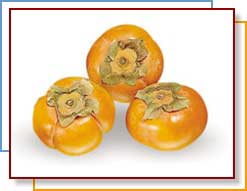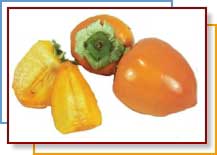
Persimmons origins go back to ancient China. Fate intervened in the 1880’s when a United States Commander brought back a native Japanese
persimmon variety to Washington, D.C. Now, persimmons are grown in
California where hundreds of different varieties flourish. This brightly
colored, glossy orange red skinned fruit is an excellent source of vitamin
A, a good source of vitamin C, and rich in fiber.
Although there are countless different varieties of persimmons, only two
are commercially available. There are distinguishable by their shape.
Hachiya: This type of persimmon makes up approximately 90 percent
of the available fruit. It is identifiable by its acorn like shape. This
persimmon is tart until it becomes soft ripe.
Fuyu: This persimmon is gaining popularity here as it is in Japan.
Similar in color, but looking like a squashed tomato, this variety is
smaller, sweeter, and is edible while still firm.
| |
|
Persimmons |
Serving Size
1 med. persimmon (168g)
|
Amounts
Per Serving |
% Daily
Value |
| Calories 120 |
|
| Calories
from Fat 5 |
|
| Total Fat
0g |
0% |
| Saturated
Fat 0g |
0% |
|
Cholesterol 0mg |
0% |
| Sodium
0mg |
0% |
| Total
Carbohydrate 31g |
10% |
|
Dietary Fiber 6g |
21% |
|
Sugars 21g |
|
| Protein 1g |
|
| Vitamin A |
50% |
| Vitamin C |
20% |
| Calcium |
2% |
| Iron |
2% |
* Percent Daily Values are based on a
2,000 calorie diet. |
|
| |
|
Persimmons are widely available September through December, with a peak
during November.
Choose persimmons with deep red undertones. Look for persimmons that are
round, plump, and have glossy and smooth skin. Avoid fruits with
blemishes, bruises or cracked skin and missing the green leaves at the
top. Select ripe persimmons only if you plan to eat them immediately.
Otherwise, buy firmer fruits and allow them to ripen.
Ripen persimmons at room temperature in a paper bag with an apple or
banana. Store them in the refrigerator when ripe. Be sure to eat the fruit
as soon as possible because overripe persimmons quickly turn to a mushy
texture.
Ripe Fuyu persimmons, which look kind of like flattened tomatoes, will be
crisp, while the acorn-shaped Hachiyas will be very soft and juicy.
Unripe Hachiya persimmons taste very bitter and will suck all the moisture
from your mouth — not very pleasant. The tartness will go away as the
fruit ripens.
Recipes
 Persimmon
and Apple Salad Persimmon
and Apple Salad
Makes 6 servings
Each serving equals 1/2 cup of fruit or vegetables
Ingredients
1 Tbsp walnut pieces, toasted
2 Tbsp orange juice
1 Tbsp sherry vinegar
1 Tbsp olive oil
3 sweet variety apples, rinsed, cored, and thinly sliced lengthwise
3 firm-ripe Fuyu persimmons, rinsed, stemmed, and thinly sliced
lengthwise
In a bowl, combine orange juice, vinegar, and olive oil. Add apples,
persimmons, and toasted walnuts and mix to coat.
Nutritional analysis per serving: Calories 90, Protein 0g, Fat 3g,
Calories From Fat 29%, Cholesterol 0mg, Carbohydrates 16g, Fiber 3g,
Sodium 15mg.

Find more in our
recipe database!
|



